 |
 The Happy Daylily Blog - daylily pictures and thoughts from my garden
The Happy Daylily Blog - daylily pictures and thoughts from my garden

|
 September 25th, 2019 September 25th, 2019 |
The humidity was down a little today so I decided to do my daylily fall fertilization. Early fall is the best time to fertilize here along the gulf coast. There are still a couple of months of warm to mild temperatures which are optimal for plant growth and fertilizing in early fall gives new foliage growth time to harden off in case we get any freezing temperatures in December or January.
One of the most common questions I get is what type of fertilizer to use. I've been using a 15-5-10 ratio fertilizer but this year I decided to use a more balanced 13-13-13, at least for this one application. The middle number (phosphorus) can build up in the soil if used too heavily over the long term, but it's still important for good blooming. I have a good feeling about 2020's bloom (smile)!
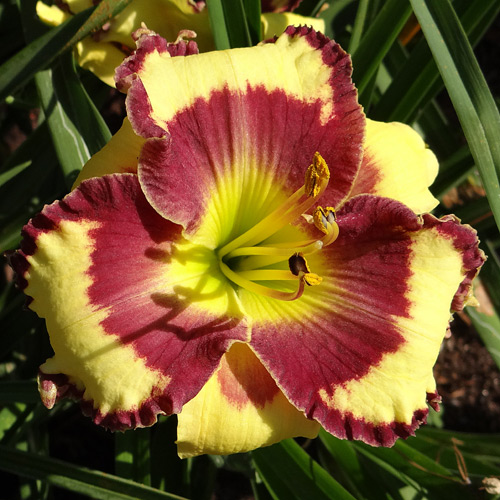
Seedling 14-019
Seedling 14-019 has 6" blooms on 24" scapes and comes from the cross (Edwardian Charm X Happy Halloween).
|
 September 24th, 2019 September 24th, 2019 |
After only one decent rain since August 1st, things finally turned around. Thanks to a tropical storm, we had four straight days with rainfall of an inch or more. This included one day where we got in excess of 10". The daylilies are ecstatic but my lawn is wondering where all the mulch came from (I have raised beds and the heavy rain washed much of it onto the lawn).
Daytime temperatures are still around 90 with outrageous humidity but I've been able to get some weeding time in. No cool front in sight.
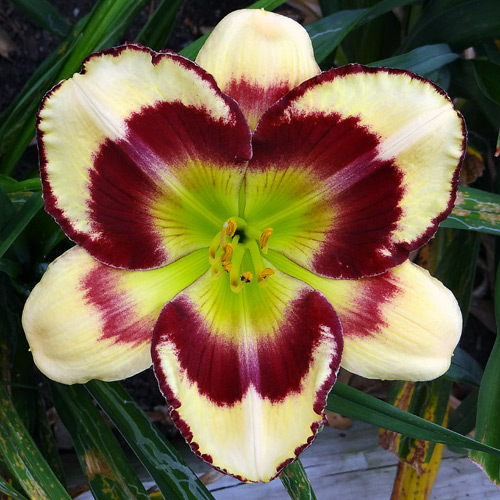
Seedling 16-138
This is seedling 16-138. It has 6" blooms on 29" scapes and comes from the cross (John Hawkins X Hedwig's Eyes).
|
 September 15th, 2019 September 15th, 2019 |
The bad news is that the heat isn't giving up... the good news is that the countdown to the first fall front in now in weeks instead of months. I'm still working on the weeds, mostly spurge, which can pop up so quickly.
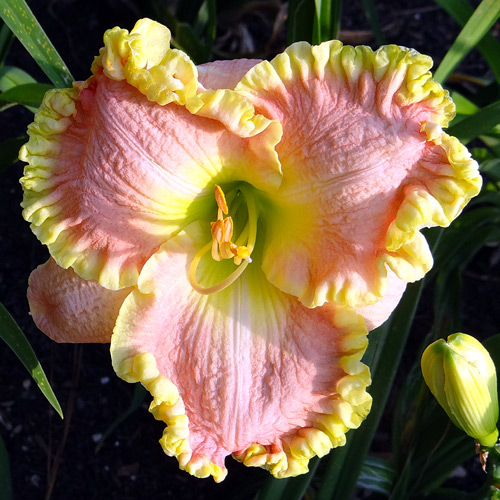
Seedling 12-032
Today's image is seedling 12-032. It has 6" blooms on 28" scapes and comes from the cross (What A Surprise X Sweet Tranquility).
|
 September 11, 2019 September 11, 2019 |
I've been a little preoccupied lately putting together a couple of video programs for the Houston Hemerocallis Society to show at club meetings. I've still been puttering in the garden but a 5-day heat wave with temps of 100 or more has kept me from doing anything meaningful. Cooler weather is drawing closer.
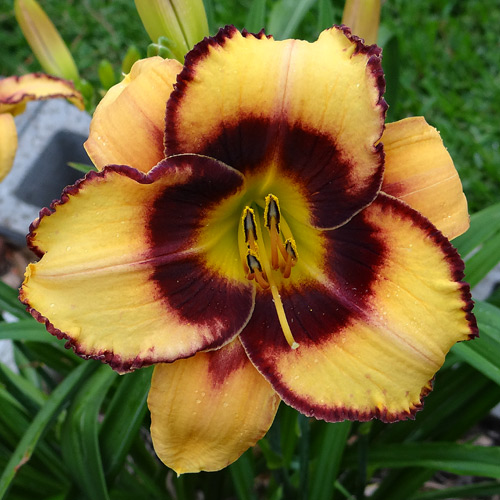
Seedling 14-029
Seedling 14-029 has 5.5" blooms on 27" scapes. It comes from the cross (Goldenzelle X Bella Vita). It multiplies like a weed and has to be divided every couple of years or so.
|
 September 2nd, 2019 September 2nd, 2019 |
Cooler weather is about a month away so it's time to do some post-summer garden cleanup. This includes removing dried foliage and any remaining spent scapes. When the first cool front comes I don't want to be doing mundane tasks. I want to be ready to get started on my fall to-do list.

Seedling 16-013
Seedling 16-013 has 5.5" blooms on 26" scapes. It comes from the cross (Blue Eyed Angel X Celestial Shore).
|
 August 27th, 2019 August 27th, 2019 |
I finally finished updating my daylily database with pictures from the 2019 season. This year I decided to take more pictures in full sun. I still occasionally had to use a sunlight diffuser but only with the lighter colors like creams and yellows. The full sun always tends to make those images appear washed out even though I take the pictures in the early morning. That's one of the faults of 'point-n-shoot' cameras IMHO. Perhaps some day I'll learn how to manually adjust the camera settings to correct this.
The big surprise for me was the improved quality of the majority of the images when taken in direct sunlight. They were more natural looking. I keep an image of each seedling in my daylily database and with so many new images that looked better than previous images it took me about three days to get them all updated. That's now done and checked off the to-do list.
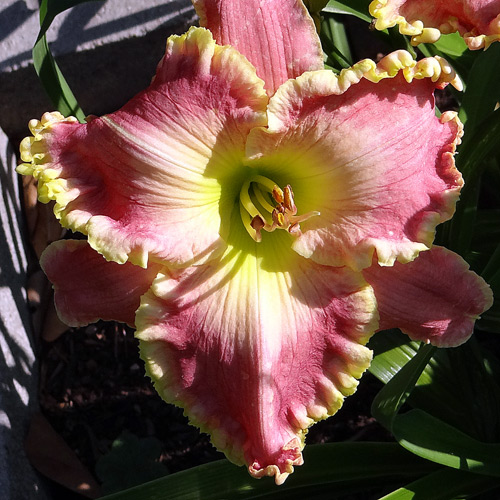
Seedling 16-064
Seedling 16-064 has 6.5" blooms on 25" scapes. It comes from the cross (Cimarron Rose X Rose Sensation).
|
 August 23rd, 2019 August 23rd, 2019 |
Summer has been flying by and I still have some unfinished items on my to-do list. Yesterday I ticked off one of them when I replaced some missing plant markers in the garden. Most growers I know keep track of which daylilies are planted where. Some maintain garden maps while others place garden markers to identify each plant. I do both. I use a garden map as a permanent record of what's where and I use garden markers to help me remember what's what when I'm in the garden.
Many sellers ship daylilies with plastic name tags attached. The daylily names are usually written with a sharpie or graphite pencil. When planting new plants I like to throw the plastic name tag in the bottom of the planting hole. This gives me one more fall-back method just in case I drop the ball in my other records. Being underground the tag will usually remain legible for years.
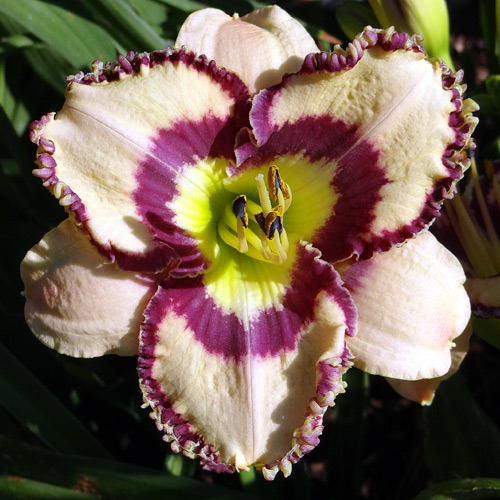
Morning Rendezvous (Jarvis, 2017)
Morning Rendezvous has 5.5" blooms on 26" scapes and comes from the cross (Spacecoast Sea Shells × sdlg).
|
 August 21st, 2019 August 21st, 2019 |
The amount of things on one's To-Do list will always expands to exceed the amount of time available. I could expound on this but I'm sure y'all know what I'm talking about (smile).

Seedling 16-107
After transplanting this from pot to the ground, seedling 16-107 has been a pleasant surprise. The bloom is a pale yellow cream with a decent edge and it opens fairly consistantly (always a plus). It has 5.5" blooms on 29" scapes and comes from the cross (Elegant Expressions X Fringy).
|
 August 12th, 2019 August 12th, 2019 |
Continuing my crown rot thread, here are some things I try to remember to minimize crown rot.
- Daylilies don't do well if the soil remains constantly wet in high heat. Constantly wet soil can promote growth of pathogens that can cause crown rot. Many years ago I thought that watering heavily every couple of days would keep the plants healthy. Long story short... after a few weeks, daylilies started dying from crown rot. Being new to growing daylilies I didn't know what was happening and continued to water every couple of days. That year I lost over 100 daylilies which was well over 25% of all the plants in my garden. Fortunately, I later found out that overwatering was the primary cause.
- Even though daylilies don't like constantly wet soil, they do need regular watering. Just let the soil dry out between waterings but don't let it remain dry for too long. Extended periods with dry soil and high heat can stress the plants making them more susceptible to rot.
- Promote the growth of beneficial microbes in the soil. I've read that having lots of good soil microbes makes it more difficult for the soil pathogens to survive. I'm not sure if that's true or not but having healthy soil promotes healthy plants and healthy plants are less susceptible to rot. One product I use is called "Garrett Juice Pro". It contains lots of natural things to improve the soil including Mycorrhizae and Soil Microbes. I apply it as a soil drench but it can also be used with foliar feeding.
It should be noted that I have not been able to completely eliminate rot in my garden. I suspect this is because the pathogens live naturally in the soil in Houston. Furthermore, I grow many daylilies increasing the possibility of having a weakened or stressed plant.
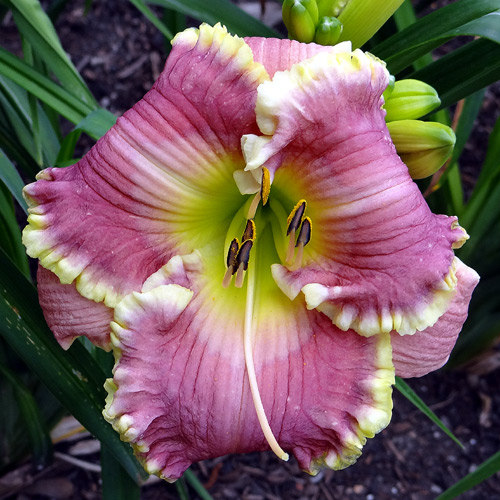
Seedling 16-056
Today's image is seedling 16-056. It has 5.5" blooms on 26" scapes and comes from the cross (Jennifer Trimmer X Blue Eyed Angel).
|
 August 10th, 2019 August 10th, 2019 |
Crown rot has made its summer appearance in my garden. Crown rot can make a healthy plant or clump suddenly begin to turn yellow and die within a matter of a few days. The crown and roots will turn mushy and have an unmistakably pungent odor. I've been told that the bacteria or virus (not sure which) that causes crown rot naturally occurs in our soil. I've also been told that the rot primarily affects weak or stressed plants and over the years I've seen this to be true. In addition there are some plants that are known to be susceptible to crown rot and most hybridizers avoid using them in their crosses.
A little over a week ago I started seeing some yellowing in one of the seedlings and shortly thereafter it died. Yesterday I noticed the seedling right next to the one that rotted was now turning yellow. When a daylily dies from rot it's important to immediately remove the dead remains and the soil immediately around the roots. This is because even though the plant seems to be dead, if the roots remain in the soil the rot pathogens will continue to grow and multiply as they consume the entire root structure. This high concentration of pathogens then can slowly migrate through the soil looking for another place to grow. In a daylily garden like mine another daylily is never that far away so removing as much of the infected soil as possible can often stop the rot from spreading. I should have removed the first plant as soon as it died.
It's important to remember however that following good gardening practices can minimize the amount of summer rot losses. Typically, I'll lose between 2 and 5 daylilies each year out of the 300+ that I grow. Not a big percentage. In my next post I'll post about the garden practices I use to try and minimize rot.
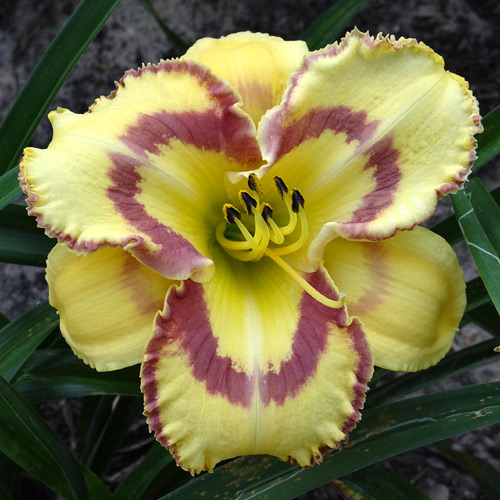
Serengeti Sunrise (Jarvis, 2017)
This is Serengeti Sunrise. It has 5.5" blooms on 23" scapes and comes from the cross ((Exotic Treasure x (Hedwig's Eyes x Spacecoast Gold Bonanza)) X New Paradigm).
|
 August 7th, 2019 August 7th, 2019 |
It looks like we're about to have our first heat wave of the summer. Temps are predicted to hit 100 or more for the first time this year. The good news is that the relative humidity may be a little lower in the morning - it certainly was this morning. The bad news is that it will probably be almost dark before it cools off enough to enjoy being outside.
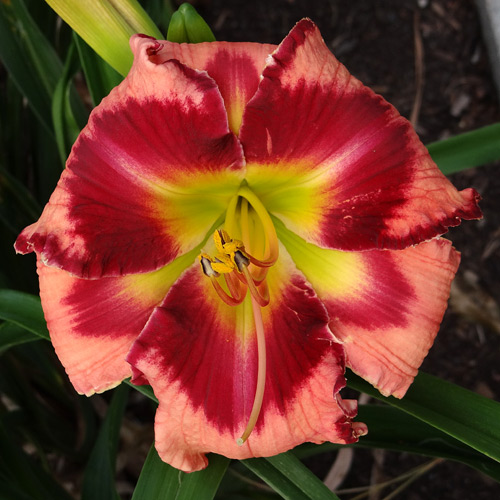
Seedling 15-066
This is seedling 15-066. It has 6" blooms on 29" scapes and comes from the cross Mississippi Memento X Thomas Tew.
|
 August 2nd, 2019 August 2nd, 2019 |
I finally got around to entering FBO (first bloom open) dates into my database. Each year I keep track of the first date each cultivar blooms. The objective is to help identify the 'season' for registration purposes. When a daylily listed as E, M, L, etc... it indicates when during the bloom season that cultivar tends to bloom (Early, Midseason, Late, etc...).
Keeping track of FBO dates helps when making the season determination but it isn't foolproof. Over a 3-year period some seedlings are very consistent, varying only a day or two from year to year while other seedlings can vary up to a couple of weeks. When there's a big variance it can often be traced to some specific situation. For example, dividing or moving a daylily can throw off the bloom season the following year.
Another consideration is how much sun a daylily gets. I have one bed in the front yard that does not get enough sun due to the neighbor's oak tree that gets bigger every year. Some of the seedlings in that bed were divided a couple of years ago and the excess was planted in the back yard where there's plenty of sun. The seedlings in the front yard beds seem to bloom a week or two later than the same seedlings planted in the back in full sun.
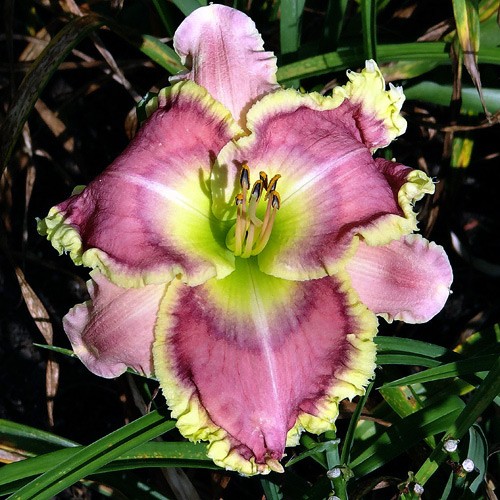
Seedling 14-024
Today's image is seedling 14-024. It has 6" blooms on 26" scapes and comes from the cross (Cimarron Rose X Priscilla's Smile).
|
 July 27th, 2019 July 27th, 2019 |
While pinks seem to almost always fade during hot temperatures, other colors tend to be more dependable. The picture below was taken in early June. The colors are just as vivid as the pictures taken back in late April. This gives it points in my evaluation as it maintains good color during hot temperatures.
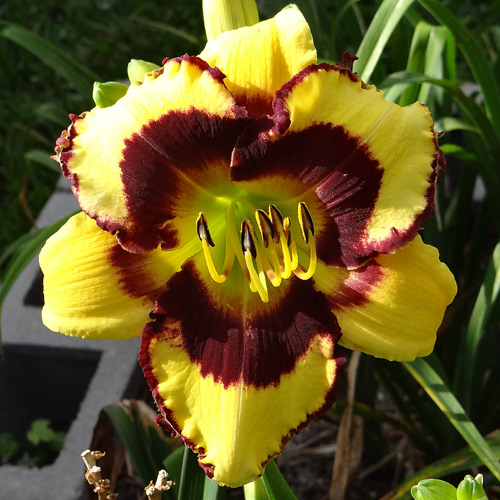
Seedling 15-024
Seedling 15-024 has 5.5" blooms on 29" scapes and comes from the cross (Hedwig's Eyes X Dragon Knife).
|
 July 25th, 2019 July 25th, 2019 |
I've posted before about the toll our hot summer weather takes on the color of some daylilies, primarily pinks and reds. This became very apparent today. On Monday, What Love Can Do bloomed and the bloom was completely light yellow. The picture below shows what it looked like back on May 15th. Monday night, a cool front came through and changed the temperatures from lows around 80 and highs in the mid 90's to lows in the upper 60's and highs in the upper 80's with low humidity. This morning What Love Can Do bloomed again and the bloom was pink!
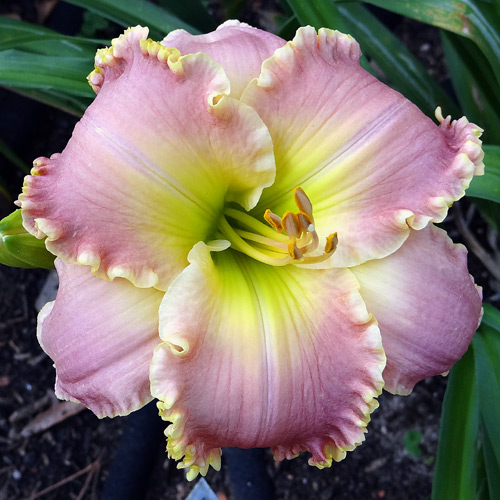
What Love Can Do (Jarvis, 2010)
What Love Can Do has 5.5" blooms on 30" scapes and comes from the cross (Spacecoast Starburst X Ruffled Masterpiece).
|
 July 21st, 2019 July 21st, 2019 |
Today was the FDWB day (First Day Without Bloom). To me it's a sad day because it signals that daylily bloom season is now officially over. Sure, there are a scattering of blooms still to come as there are even now at least 3 new scapes emerging. But blooms will be few and far between.
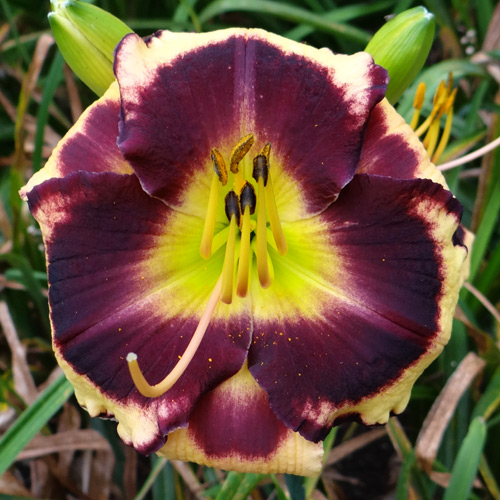
Seedling 15-009
Today's seedling is 15-009. It is strongly recurve with most blooms being in this bagel shape making the eye appear to almost cover the bloom. On the downside however, the blooms are often not symetrical. Personally, I find the most pleasing blooms to be those that if a line was drawn from the top to the bottom of the bloom, each side would be a mirror image of the other side. Yes I know... that's expecting a lot, but it's what pleases my eye. 15-009 has 6" blooms on 30" scapes and comes from the cross (Mississippi Memento X Thomas Tew). The recurve shape comes from Thomas Tew.
|
 July 17th, 2019 July 17th, 2019 |
Daylily blooms are getting pretty sparse with only a couple showing today. There are still a few scapes so we're not done yet.

Seedling 14-073
Today's image is seedling 14-073. It has 6" blooms on 28" scapes and comes from the cross (May I Have This Dance X Hog Heaven).
|
 July 15th, 2019 July 15th, 2019 |
Back in 2014, due to work requirements in my 'day job', my daily check of new seedlings was often done in the evenings. Early evening is not the optimum time for daylily blooms but I wasn't going to let my job prevent me from selecting new seedlings for evaluation. I can distinctly remember rushing to see everything before it got too dark yet repeatedly stopping to look at one particular seedling. My initial observations were that it wasn't round and full (the way I like), it didn't have much of a bud count, and it was lavender (probably my least favorite color). I think I must have stopped to look at it 4 or 5 times before I realized why it kept catching my eye.
What attracted my attention was the bright yellow cirular eyezone which made the seedling distinctive. Recently I asked some knowledgeable daylily folks how they would classify the yellow pattern and was surprised at the range of answers. The responses I received included 'applique throat', 'band', 'watermark', and 'halo'. An applique throat is defined in the ADS online dictionary as "an opaque color pattern originating in the throat and extending outward onto the midrib and tepal surfaces. The strong contrast and sharp distinct edges of an appliqued throat show no color bleeding into the surrounding petal tissue.". Based on this description, I agree with those who said it was an applique throat.
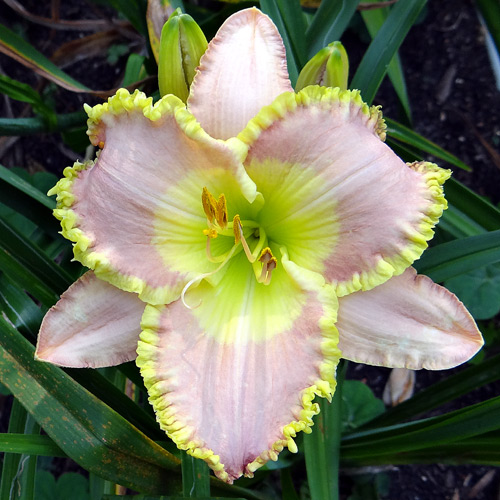
Seedling 14-080
Seedling 14-080 is that seedling and it turned out to be a decent daylily. It has a bud count in the mid 20's on 26" scapes. Because it opens so flat the bloom can sometimes measure 7" although it's typically closer to 6.5". It comes from the cross (Sweet Tranquility X Priscilla's Smile).
|
 July 10th, 2019 July 10th, 2019 |
Today's image is seedling 16-156. When growing in a pot it hadn't been anything special but this year with it planted back in the ground it really took off. The plants grew vigorously producing large fans. Bloom size increased to 6.5" and the bud count was in the 20's. In addition, it sent up 3 sets of scapes and I even saw a fair amount of doubling on the 3rd set, something it hadn't done before.

Seedling 16-156
Parentage of 16-156 is (Daydream Spirit X Patsy Cline).
|
 July 6th, 2019 July 6th, 2019 |
Yesterday I found a few "prolifs" in the daylily beds. A prolif (or proliferation) looks like a small fan growing part way up a spent scape. Some cultivars are known to produce lots of prolifs while most seldom if ever produce any. A couple of the most common questions I get are can prolifs be rooted and if so, are the resulting blooms the same as the mother plant. The answer to both questions is "yes". So how does one root a prolif? There are multiple ways such as rooting in a glass of water or rooting in a pot placed in a shady location. My favorite however is the lazy man's way and works as follows.

Prolif ready to plant
First, I select only prolifs that are starting to show root formation where it's attached to the scape. The above example shows well formed roots but even a single nub of a root shows the prolif will probably root fairly easily. I have rooted prolifs without any roots but success rates are much lower. I remove the prolif from the scape leaving 1.5" of the scape below and about 1" above. Then I trim the foliage leaving about 2-3" (see above). After determining which side of the mother plant gets the most shade from the sun, using a pencil I make a 2" deep hole up close to the mother plants. The trimmed prolif is then pushed into the hole so that the base of the prolif where the roots are is about a half inch into the soil. After that, it's just a matter of making sure the plants are watered regularly. Eventually, the prolif will start putting out new foliage which tells me rooting has been successful. This same procedure can be used to root prolifs in pots placed in the shade.
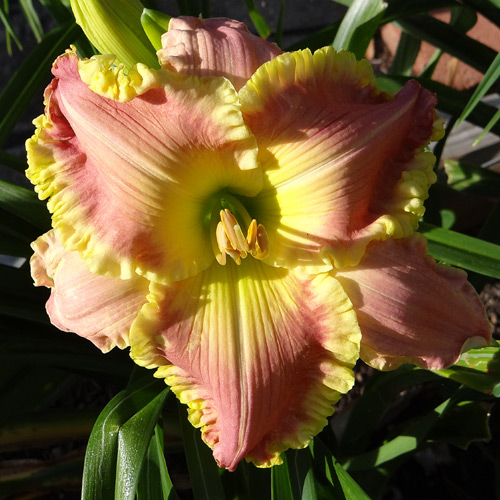
Seedling 16-065
Today's image is seedling 16-065. I has 7" blooms on 28" scapes and comes from the cross (What Love Can Do X Sarah Starchak).
|
 July 4th, 2019 July 4th, 2019 |
Thunderboomers announced their presence during the wee hours of the morning and blessed the garden with 1.3" of rain. There's been lots of rain in the past 10 days but it appears to be over for a while. Keeping the hoses at the ready!
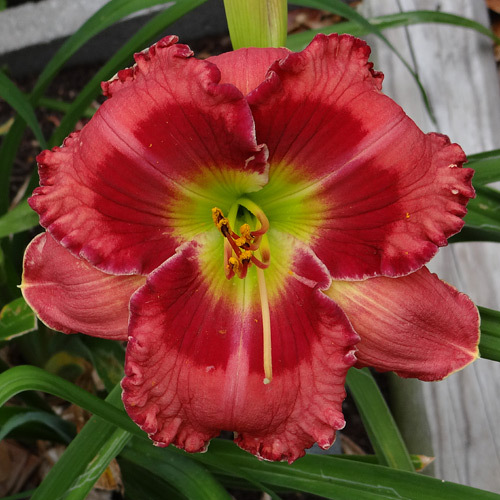
Seedling 13-001
I thought today's image should be appropriate colorwise for the 4th of July. Seedling 13-001 always blooms early and therefore is welcome in the garden. The blooms open consistantly, the color is bold, it repeats well, and the plants clump up fairly quickly. Unfortunately, it doesn't have a bud count worthy of registration (IMHO). Still... I'll probably keep it around for my own enjoyment because it's a pretty face. It comes from the cross (Wild Cherry Round Up X Walter Kennedy).
|
 July 2nd, 2019 July 2nd, 2019 |
Yesterday I removed the spent scapes from the back yard beds. Not all the scapes but just the ones that had dried enough to easily be removed. I prefer not to cut spent scapes that are still green because I believe the plant will draw back the plant juices from the scapes as part of natural processes. Just my humble opinion of course (smile).
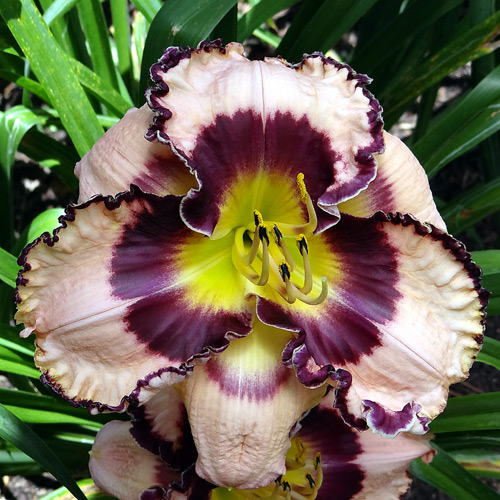
Seedling 16-117
Today's image is seedling 16-117. It has 5.5" blooms on 28" scapes and comes from the cross (Midnight Amulet X (Mask Of Eternity x (Islesworth x Awesome Blossom))).
|
Previous Posts
 Back to current posts
Back to current posts
|

 September 25th, 2019
September 25th, 2019 September 24th, 2019
September 24th, 2019 September 15th, 2019
September 15th, 2019 September 11, 2019
September 11, 2019 September 2nd, 2019
September 2nd, 2019 August 27th, 2019
August 27th, 2019 August 23rd, 2019
August 23rd, 2019 August 21st, 2019
August 21st, 2019 August 12th, 2019
August 12th, 2019 August 10th, 2019
August 10th, 2019 August 7th, 2019
August 7th, 2019 August 2nd, 2019
August 2nd, 2019 July 27th, 2019
July 27th, 2019 July 25th, 2019
July 25th, 2019 July 21st, 2019
July 21st, 2019 July 17th, 2019
July 17th, 2019 July 15th, 2019
July 15th, 2019 July 10th, 2019
July 10th, 2019 July 6th, 2019
July 6th, 2019 July 4th, 2019
July 4th, 2019 July 2nd, 2019
July 2nd, 2019 Back to current posts
Back to current posts




















